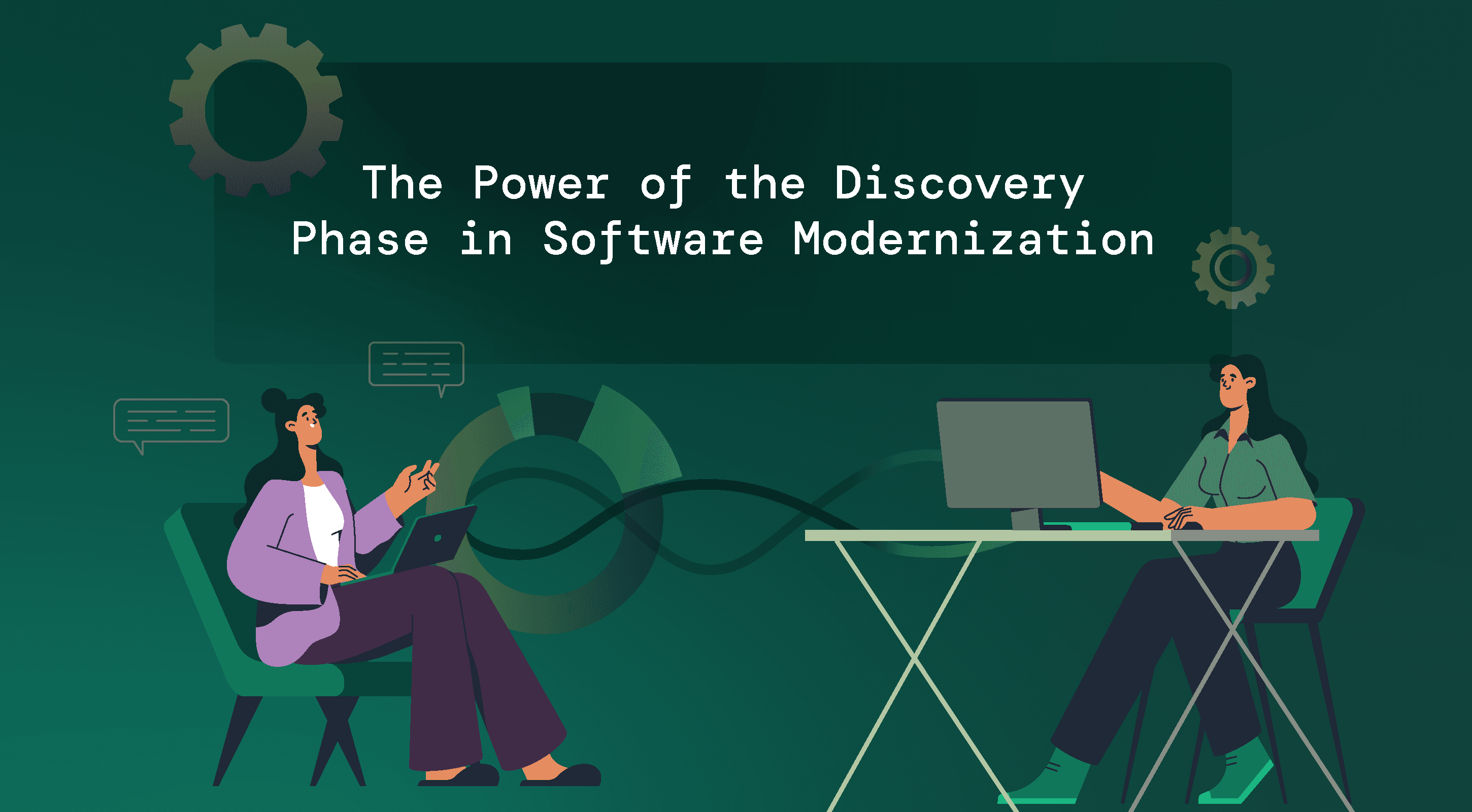The Discovery Phase in Software Modernization: Why It Matters and What to Expect (in 2025!)
The Power of the Discovery Phase in Software Modernization

Pichandal
Technical Content Writer

The world of software development witnesses a plethora of technological advancements by the day. The process of modernizing existing software becomes crucial for businesses to enhance overall operational efficiency, access new features, and save costs and time. In today’s world, staying up to date with tech stacks is the key to unlocking new doors and staying relevant in the competitive marketplace.
According to Foundry's State of the CIO Study 2024, IT leaders anticipate spending more time on transformational and modernization tasks, particularly redesigning business processes (33%), promoting business innovation (34%), updating infrastructure and applications (28%), and creating and improving business strategy (27%).
When it comes to application modernization, the discovery phase with a tech partner is the step-back moment that helps to understand the strengths, weaknesses, and opportunities for growth and set realistic expectations about time, cost, and effort. But the real kicker is, one can’t fully grasp “what’s working?” or “What’s holding the business back?” without a comprehensive discovery phase in place with the vendor.
In this article, we can take a detailed look at how the discovery phase of the project helps align business objectives, setting the stage for a smoother, more efficient modernization a successful project in 2025.
Key Elements of the Discovery Phase (and how to leverage it)

Current State Analysis
We cannot jump right into knocking down walls to renovate the house before inspecting the structure or planning the changes, can we?
The meticulous assessment of the existing system and the detailed analysis focused on the level of codebase, performance, and infrastructure is inevitable to identify bottlenecks for optimization of the application. Here are the key moves we make for the analysis of the current state of an application:
-
System Audit: Comprehensive evaluation of the code cleanliness, modularity, maintainability, system architecture (e.g., monolithic or microservices), and performance bottlenecks such as slow database queries, high CPU usage, or memory leaks with proper NDAs signed.
-
Pain Point Identification: Gathering inputs from IT and business teams to understand recurring issues, crashes, or dependencies on deprecated libraries or APIs that cause operational inefficiencies that need attention.
-
Existing Infrastructure Assessment: Reviewing the current infrastructure setup (database evaluation, cloud readiness, etc.) to understand the scalability of existing infrastructure and challenges involved for the new changes.
Vision and Scope Alignment
The Discovery Phase is the crux to ensure alignment between IT, business, and development teams. In our eighteen years of providing various Ruby on Rails services, we have clearly witnessed the importance of gathering comprehensive input from all teams. This approach paves the way for a clear roadmap for modernization projects, balancing both functional and non-functional requirements.
-
Stakeholder Collaboration: Active engagement with IT, business, and development teams means well mapping of high-level business goals of the app modernization into actionable technical requirements. Railsfactory, as a tech partner, has the practice of keeping detailed questionnaires ready during discussions to ensure doubts on the existing tech ecosystem are clarified and opportunities are well understood, addressing conflicting priorities early.
-
Technical & Business Needs: Gathering data on specific workflows as per the needs, how well the existing system can handle traffic, security breaches, etc., and documenting everything in detail with flowcharts and use case diagrams. It helps to balance functional requirements like feature upgrades (modern payment gateways, integration with third-party APIs etc.) with non-functional needs such as scalability, performance, and reliability.
-
Prioritization of Features: Maintaining the prioritization framework is critical for categorizing features effectively. This ensures that high-priority items are addressed first, followed by less urgent feature enhancements. It can help to meet clients’ expectations and overall business objectives in the smoothest way possible.
Feasibility & Impact Assessment
Once the current state of the application and requirements are clear, assessing the feasibility of transition becomes vital. This includes assessing the current tech stack compatibility and how the new changes can impact existing workflows and business processes.
-
Technical Feasibility: Reviewing compatibility between the current tech stack and proposed changes in the application to get a grasp of the app’s readiness and work on potential migration paths/strategy. We strongly advocate for the creation of prototypes wherever possible to validate ideas before committing to full-scale changes.
-
Business Impact: Collaborating with business stakeholders to plan a phased approach and workflow adjustments in order to ensure existing business operations happen smoothly without any disruptions during the process of modernization. Besides, we take the discussion to understand the possible impact on workflows and ROI in the future to plan the transition carefully.
-
Cost-Benefit Analysis: Analysing implementation, testing, and validation costs and determining the expected long-term savings by executing the revamp of the existing software application.
Risk Identification & Mitigation Planning
Spotting risks that could derail the entire process early is crucial. In this context, the scoping phase plays a pivotal role in identifying vulnerabilities in the existing system and challenges related to transitioning to new technologies. By addressing them systematically, one could eliminate unforeseen risks and losses associated with it easily.
-
Risk Identification: Investing time in identifying potential vulnerabilities through reviewing past incidents or failures, evaluating compatibility issues, and data migration challenges is crucial. It significantly helps in spotting the risks in advance in terms of the application's technical, operational, and infrastructural aspects.
-
Mitigation Planning: Identifying risks in prior is indeed a good move, but the real success lies in having the proper mitigation plan in place. Once risks are identified, we develop mitigation strategies by collaborating with IT and development teams to minimize business disruptions and negative user impact and ensure a smooth reengineering of the application.
Core Benefits of the Discovery Phase
It is not rare to see clients preferring to skip the discovery phase. But we at Railsfactory insist and propose discovery. Our team will do all the necessary research for the initial stage of discussion and communicate as needed during the discovery phase. Such an approach helps us understand the requirements from clients in all aspects, from business background, affordability, urgent needs, long-term expectations, and beyond.
This section is not just about us but also how the discovery phase benefits clients intending software modernisation in various ways. We are listing some below:

Strategic Roadmap to Application Modernisation
The well-executed discovery phase helps you have a crystal-clear roadmap handy for software modernization. No guesswork. Just a clear path forward. Through thorough analysis, you will get to understand various projects that were not considered before and technical feasibility addressed at the right time.
This way, you can align possible improvements with business objectives and ensure that modernization efforts deliver the best results.
Accurate Estimation of Cost and Time
The in-depth analysis of the codebase, system dependencies, and infrastructure during the project discovery phase helps vendors provide precise ballpark estimates. This clarity will help you plan budgets and realistic timelines with confidence, avoiding costly mistakes or any unexpected surprises later.
Reduction of Risks and Mitigation Plans
The discovery phase helps you fix the roof before the rain starts. By digging deep into the existing setup of the application, you can find hidden issues like compatibility challenges or outdated dependencies early and get insight into what solutions vendors are having to get it done smoothly. This level of evaluation in the discovery phase helps you assess if the vendor team is the right fit or not to meet your requirements.
Enhanced Collaboration and Stakeholder Buy-In
By getting all hands (IT, business, and development teams) on deck during the software discovery phase, both parties can ensure everyone is on the same page and share a unified vision of the project’s goals and strategy. This contributes to building long-term trust and commitment across the board.
Minimized Scope Creep
The detailed breakdown of the application in the discovery helps you set the ground rules clearly by defining the project’s objectives and limitations upfront. This way, it prevents mid-project changes, timeline deviations, and cost inflation. Ultimately, it increases the chances of making well-informed decisions based on data and insights, rather than on a general understanding.
Improved Operational Efficiency
As the initiation phase leads to spotting the kinks within the existing system early, it automatically leads your tech partner to plan for apt solutions for modernizing the application successfully. As a result, once the project kicks off, they will implement automation wherever possible, reduce redundant work, and prioritize high-impact tasks with ease.
It is like just tuning the well-oiled machine as all other parts are already in sync. This level of clarity will undoubtedly enhance the productivity of the team and overall operational efficiency.
Best Practices for a Successful Discovery Phase

It is 2025, and the digital transformation is accelerating. Making your best with every step you take is crucial to standing out and keeping your money pot heavy. Here we list some of the best practices we follow, at Railsfactory, during the project's discovery phase and why we think it matters the most.
Prioritize Modernization-Specific Challenges
Modernizing an application is not about just slapping on a fresh coat of paint in an old building and calling it done. Rather, it is more about allocating adequate time and resources to dig into the foundation.
Always focus on spotting the challenges in prior, fixing the cracks, and ensuring everything is structurally sound for the modernization process. As the ageing systems need careful attention, never rush through the process. When it comes to building a system to last, slow and steady is the prompt approach.
Involve Main Teams Early
As each team (IT, business, and development) brings unique expertise to the table, which is vital for the success of the project, making sure to involve all key players right from the start is crucial. Besides, by ensuring their inputs early, we can steer clear of unexpected roadblocks/expectations and get a unified vision for the finish line.
Instead of risking misalignment in the plan or spinning your wheels later, it is better to postpone decisions or meetings if the right people are not available. Keeping communication open with all teams will make sure everyone’s voice is heard and create a solid foundation for smoother collaboration down the line.
Document the Current and Target States
With the digital ecosystem becoming increasingly complex with so many technologies and tools intertwined, maintaining detailed documentation is essential. Before keeping hands for any changes, ensure that all present system architectures and workflows are thoroughly documented. Also, make it accessible and editable for all team members, so that everyone can update it as and when needed.
It helps new team members to easily understand the context of the project and sets a clear path to iterate without starting from scratch.
Set Realistic and Measurable KPIs
Nowadays, businesses are under tremendous pressure to deliver results quickly from every initiative. At this point in time, without setting clear and actionable KPIs, businesses can’t expect a smooth transition or journey—turbulence guaranteed.
Thus, make sure to align KPIs with both short-term and long-term business goals and use data-driven metrics to track the progress of the project accurately. It will keep the project focused and build confidence among stakeholders that the effort is driving meaningful outcomes.
Overcoming Common Challenges in the Discovery Phase

Final thoughts
According to McKinsey’s research, 17% of IT projects fail due to company closures, 45% exceed their planned budgets, 56% deliver fewer benefits than initially anticipated, and approximately 7% complete the projects later than scheduled.
We double down that business leaders can increase the likelihood of success by multiple times with preliminary comprehensive analysis of the project scope in the discovery phase. Particularly, when it comes to software modernization, the discovery phase of the project acts as a backbone, leaving no chances to turn a blind eye to any necessary details. From technical realities to business objectives with the new transition, the discovery phase will set a strong foundation and keep both parties aligned.
Simply put, in 2025, the proactive investment of time in the discovery phase of the software modernization process saves money, eliminates frustration, and ensures your project starts off on the right foot and delivers the results you envision down the road. If you are ready to work on modernizing your applications and scaling your business, feel free to contact us today. Our team can breathe new life into your projects and save your expenditures in the long run.



